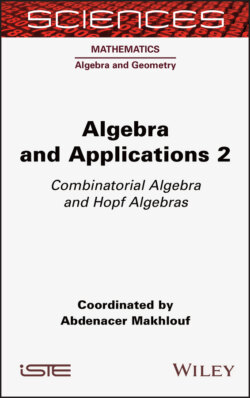Читать книгу Algebra and Applications 2 - Группа авторов - Страница 40
1.6.3. Right-sided commutative Hopf algebras and the Loday-Ronco theorem
ОглавлениеLoday and Ronco (2010) have found a deep link between pre-Lie algebras and commutative Hopf algebras of a certain type: let ℋ be a commutative Hopf algebra. Following this, we say that ℋ is right-sided if it is free as a commutative algebra, that is, ℋ = S(V) for some k-vector space V, and if the reduced coproduct verifies:
[1.83]
Suppose that V = ⊕n ≥ 0 is graded with finite-dimensional homogeneous components. Then, the graded dual A = V0 is a left pre-Lie algebra, and by the Milnor-Moore theorem, the graded dual ℋ0 is isomorphic to the enveloping algebra as graded Hopf algebra. Conversely, for any graded pre-Lie algebra A, the graded dual is free commutative right-sided (Loday and Ronco 2010, Theorem 5.3).
The Hopf algebra ℋCK of rooted forests enters into this framework, and, as it was first explicited in Chapoton (2001), the associated pre-Lie algebra is the free pre-Lie algebra of rooted trees with grafting: to see this, denote by (δs) the dual basis in the graded dual of the forest basis of ℋCK. The correspondence δ : s ↦ δs extends linearly to a unique vector space isomorphism from ℋCK onto . For any tree t, the corresponding δt is an infinitesimal character of ℋCK, that is, it is a primitive element of ℋ°. We denote by * the (convolution) product of ℋ°. We have:
[1.84]
Here, t ↷ u is obtained by grafting t on u, namely:
[1.85]
where N′(t, u, v) is the number of partitions V(t) = V ∐ W, W < V, such that υ|V = t and υ|W = u. Another normalization is often employed: considering the normalized dual basis , where σ(t) = |Aut t| stands for the symmetry factor of t, we obviously have:
[1.86]
where:
[1.87]
where can be interpreted as the number of ways to graft the tree t on the tree u in order to get the tree v. The operation → then coincides with the grafting free pre-Lie operation introduced in section 1.6.1.22.
The other pre-Lie operation ⊲ of section 1.6.1.2, more precisely its opposite ⊳, is associated with another right-sided Hopf algebra of forests ℋ which has been investigated in Calaque et al. (2011) and Manchon and Saidi (2011), and which can be defined by considering trees as Feynman diagrams (without loops): let be the vector space spanned by rooted trees with at least one edge. Consider the symmetric algebra , which can be seen as the k-vector space generated by rooted forests with all connected components containing at least one edge. We identify the unit of with the rooted tree •. A subforest of a tree t is either the trivial forest •, or a collection (t1,…, tn) of pairwise disjoint subtrees of t, each of them containing at least one edge. In particular, two subtrees of a subforest cannot have any common vertex.
Let s be a subforest of a rooted tree t. Denote by t/s the tree obtained by contracting each connected component of s onto a vertex. We turn ℋ into a bialgebra by defining a coproduct Δ : ℋ → ℋ ⊗ ℋ on each tree by :
[1.88]
where the sum runs over all possible subforests (including the unit • and the full subforest t). As usual we extend the coproduct Δ multiplicatively onto . In fact, coassociativity is easily verified. This makes ℋ := ⊕n ≥ 0 ℋn a connected graded bialgebra, hence a Hopf algebra, where the grading is defined in terms of the number of edges. The antipode S : ℋ → ℋ is given (recursively with respect to the number of edges) by one of the two following formulae:
[1.89]
[1.90]
It turns out that ℋCK is left comodule-bialgebra over ℋ (Calaque et al. 2011; Manchon and Saidi 2011), in the sense that the following diagram commutes:
Here, the coaction Φ : ℋCK → ℋ ⊗ ℋCK is the algebra morphism given by Φ(1) = • ⊗ 1 and Φ(t) = Δℋ(t) for any nonempty tree t. As a result, the group of characters of ℋ acts on the group of characters of ℋCK by automorphisms.
